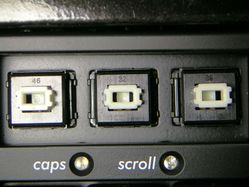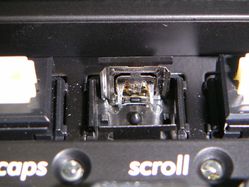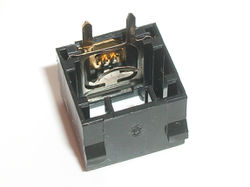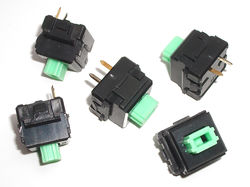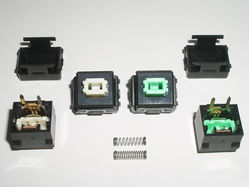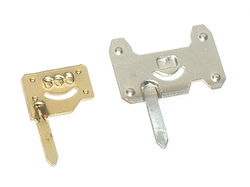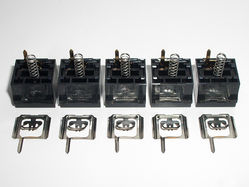Xiang Min KSB series
 | |
| Manufacturer | Xiang Min |
|---|---|
| Product code |
KSB-C (clicky) KSB-N (linear) KSB-LE (linear with LED) |
| Switch type | Clicky; linear |
| Sense method | Metal leaf |
| Actuation force | 60±15 cN |
| Keycap mount | Alps mount |
| Switch mount | Plate mount |
KSB series is Xiang Min's four-tab clone switch series. KSB series switches are referred to as "XM" by Filco and Ducky.
Contents
Description
The metal parts inside Xiang Min switches are very similar to those found inside current Hua-Jie AK series switches. Linear and clicky switches have the all-over (gold?) plated stationary contact of Hua-Jie AK-CN2 (2) switches, which are their reduced lifetime range. The clicky switches use a narrow phosphor bronze "mantis foot" click leaf. There are two designs of movable contact in use, with different crossbar designs. The crossbar is shaped such as to stay clear of the return spring when the slider is home, and it can be either straight and stepped, or curved.
The LED switches however use completely different internals, with the same stationary contact as alps.tw Type T1 and an unusual variant of the T1 movable contact, with reduced separation between the two "fingers".
Xiang Min switches do not carry any identifying marks.
Specifications
According to the Xiang Min website, all current models are rated as follows[1]:
| Contact arrangement | SPST |
| Maximum rating | 10 mA 12 V DC |
| Contact resistance | 1 Ω maximum |
| Total travel | 3.5±0.5 mm |
| Pretravel | 1.5±0.5 mm |
| Operating force | 60±15 cN |
| Lifetime | 5 M (KSB-C/N), 6 M (KSB-LE) |
Variants
KSB switches typically have ivory or green sliders. The clicky switches are noted for being significantly stiffer than Alps and Fuhua switches, with strong tactility.
KSB-C
Clicky, with an ivory slider. 65±15 cN according to the specification, and 60±15 cN according to the website.
Ducky use a customised clicky variant reduced to 55 cN in force, with a green slider.
KSB-N
Linear. 65±15 cN according to the specification, and 60±15 cN according to the website. Xiang Min's 2012 production run samples use a green slider, but the slider is black in Ducky keyboards.
KSB-LE
Linear with space for an LED in place of the click leaf. Green slider in the Tactile Pro 3, and translucent white slider in Xiang Min's 2012 production run. 60±15 cN according to the specification and website.
Unlike most Alps-style switches, KSB-LE switches cannot be opened up while soldered in place, because the LED sits on two steps in the LED recess. This is likely true of all Alps and Alps-style switches with LED cutouts.
Mould numbering
The following mould numbering styles have been identified for non-LED switches:
- N:A##
- N:##
The two styles appear to run in parallel.
"XM"
Filco displayed "XM" on the outside of the product box for the KSB-C Filco Zero, and Ducky used "XM" in the product codes for the KSB-based variants of the Ducky DK1008 (DK1008XM) and Ducky DK1087 (DK1087XM). Filco's use of "XM" might have been the cause of all copper click leaf four-tab clones being referred to as "XM" switches (with four-tab clone split between "Simplified Alps Type II"/"XM" (copper leaf) and "Simplified Alps Type IV" (wide steel leaf). However, this is now known to be a mistake, as the keyboard most cited to use "XM" switches, the SIIG MiniTouch, is confirmed to have used Hua-Jie AK series switches.
Any keyboard description citing "XM" switches should be queried, with the exception of the aforementioned Filco and Ducky products, and the Matias Tactile Pro range. Also to be ruled out are switches manufactured before Xiang Min introduced their range of keyboard switches in 1997. Xiang Min did not exist before 1994.
Keyboards
Few keyboards are confirmed to use KSB series switches. While many keyboards have been claimed to use "XM" switches, this is dubious, as previously explained. The following keyboards are known to use Xiang Min KSB-series switches.
- Early Filco Zero (white KSB-C, clicky)
- Matias Tactile Pro 3 (up to late 2012; used for the LED keys; green KSB-LE, linear)
- Ducky DK1008 and Ducky DK1087, XM variants (green clicky KSB-C and black linear KSB-N; white KSB-LE used for LED keys in both keyboards)
Gallery
Green KSB-LE alongside Alps SKBM White
KSB-C switches in a Filco Zero showing numbering
KSB-C switches in a Filco Zero showing contact assembly
KSB-C
Numbering compared to Taiwan Tai-Hao APC series
KSB-N is very similar to the above, differing primarily in the slider colour and lack of click leaf. The upper shell does use different moulds, but the only significant difference is the smaller numbering; there is provision for a click leaf to be inserted. The base appears to be from the same set of moulds.
KSB-C and KSB-N always use north numbering, either N:A## or N:## in varying styles.
Ducky specification
Ducky ordered customised 55 gf KSB-C and KSB-N switches from Xiang Min. While the only change with Ducky-specification KSB-N switches appears to be the slider colour (the springs look identical), Ducky-specification KSB-C switches have a more tightly coiled spring to reduce the switch weight. The spring remains the same length.
KSB-N
KSB-LE
KSB-LE has a recess and leg holes for an LED.
KSB-C vs KSB-LE
The following illustrations show KSB-C/N contact plates on the left, and KSB-LE contact plates on the right:
Crossbar design
The design of the movable contact crossbar varies between batches and seemingly within batches. Note that both variants of the movable contact have a small cutout at the top of the stamping, which is absent in Hua-Jie contacts, proving that they are in fact not the same metal parts as those in Xiang Min switches. The stationary contacts look identical, but they are also very subtly different.
| Switch | Source | Crossbar design |
|---|---|---|
| KSB-C | Filco Zero FKB108ZJB (2009 or earlier) | 1 × curved |
| KSB-C | 2012 production sample | 2 × curved |
| KSB-N | 2012 production sample | 2 × straight |
| KSBF | 2012 production sample | 2 × straight |
| KSB-C | 2013 Ducky spec | 5 × straight |
| KSB-N | 2013 Ducky spec | 2 × curved, 3 × straight |
References
- ↑ Xiang Min — Keyboard Switch Retrieved 2015-08-03.


